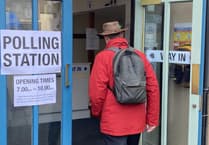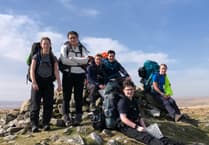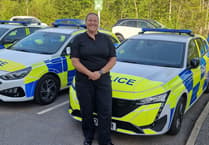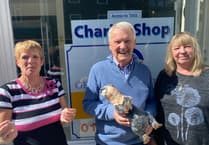THE first American troops arrived in Britain in January 1942 only seven weeks after the Japanese attack on Pearl Harbour.
There can be no doubt the unlimited manpower and huge input of armaments from the United States ensured ultimate victory from the moment they entered the conflict.
Apart from members of the Armed Forces, very few people had travelled to foreign parts at that time and America was as far away, figuratively speaking, as the moon.
Our only conception of that great country arose from the cowboy films, musicals and romantic Hollywood stories based on characters who lived in palatial houses or lavish apartments.
The 29th US Infantry Division, commanded by Major General Charles H Gerhardt, was the first arrival to the local area and set up camp in June 1943 on Whitchurch Down with its headquarters at Abbotsfield House (now Abbotsfield Hall Nursing Home) in Tavistock.
They were a part of V Corps, United States 1st Army under Lt General Omar N Bradley and had been selected for the invasion of Europe.
The residents of the town looked with a mixture of curiosity and some surprise at the sight of very smartly dressed young men in immaculately tailored uniforms and funny hats strolling among them chewing gun, talking with their distinctive drawl and eyeing the girls with interest.
As a build up of forces prior to ‘D’ Day continued into 1944 the roads and commons over a wide area around Plymouth and Tavistock filled with tented camps and vehicles of all kinds. Everything they needed, from clothing and food to tobacco and Coca Cola was imported from the US — except water of course.
At Brentor there was a village ‘chute’ which comprised a miniature waterfall at the side of the road (it is still there) that provided pure drinking water from a spring. It became a meeting place for soldiers and a number of villagers, especially children, when they came every day with lorry loads of ‘jerry’ cans to replenish their supplies.
For the Americans, being far from home and missing their families, they enjoyed spoiling the local youngsters with chocolate perhaps or packets of gum. Often they would tell children to tell their ‘moms’ to let them have jars or tins which they filled with tea (as valuable as gold dust to the recipients) or sugar — items which were strictly rationed in wartime Britain. Lucky youngsters would sometimes get invited for high speed rides in a Jeep whilst their comrades got the water.
Christmas 1943 was a memorable one for children who lived in and around Plymouth and Tavistock. They were treated with typical American generosity to celebration parties with gifts and sweets and food on a lavish scale compared to the austere wartime rationing allowances.
One Saturday they commandeered one of the two cinemas in Tavistock when every child was invited to a film show, the entrance ‘fee’ being an empty glass jar or some old newspapers for recycling towards the war effort.
The children were welcomed with smiles and wisecracks as well as a numbered ticket for the raffle that took place half way through the show. One lad won a baseball bat but didn’t know what to do with it afterwards and it simply became a memorable relic with which to remember a happy event.
The kids watched Walt Disney cartoons and a cowboy film and on their way out there were the Army boys with huge kitbags from which they took large packed of ‘candies’ for each of them.
Soldiers, sailors and airmen of many nationalities appeared in Tavistock from time to time but the Americans outnumbered them and seemed to be everywhere at all times. They played baseball in the meadows and there was a social club for them in West Street.
In Duke Street there used to be a large garage (Matthews Garage) where a lot of repair work was done to US Army vehicles by their own mechanics.
A favourite ploy was to ask the nearest one ‘are you a cowboy mister?’ Often he was not but on occasion he would call out ‘Hi Tex! These guys want to meet a cowboy’ and tall ‘Tex’ would come out smiling to be viewed with wonderment and some disappointment at his headgear — the inevitable baseball type cap with the peak turned up in jaunty manner.
They attracted the girls too — the best seats in the cinemas were occupied by them and their young lady friends, the sight of which caused envy among the uniformed British as well as some local lads.
Sad to say, a section of the community looked down on young women who went out with ‘the Yanks’ which was unkind to say the least as the vast majority of them were disciplined, courteous and well-behaved.
There was never any serious trouble in the town except a few scuffles on a Saturday night. The military police patrolled the town wearing their distinctive white helmets — people called them ‘snowdrops’ — and any soldier found misbehaving was quickly taken into custody and whisked back to camp.
On a happier note, at least 40 American soldiers married local girls. One young lady was courted by a handsome American soldier. He was madly in love and would pace up and down some distance from where she lived, unwilling to call because her mother was a rather fierce woman.
Eventually he would ask some boys playing nearby to kindly go and see if she was coming out or not. One of them would run to the house but before he got to the door an upstairs window would open, a smiling face would appear with a whispered assurance she wouldn’t be long. They became engaged and married.
Her fiancée survived the war and was returned straight home with his unit from where he sent her the cost of the fare to cross the Atlantic on the pride of the United States merchant fleet, the luxury liner SS ‘America’. Most ‘GI Brides’ were packed onto crowded ships specially chartered for the trip and many of them did not find the idyllic ‘home on the range’ they had been led to expect.
In February 1944, the Supreme Allied Commander, General Dwight D Eisenhower — who became US President in 1953 — inspected H Company of the 29th Division in Bedford Square, followed by the Commander of the 1st Army, Lt Gen Omar N Bradley who came in March to address the officers of the division.
Just before D Day General Eisenhower and the Overall Land Forces Commander, Field Marshall Sir Bernard Montgomery, met at Abbotsfield House for a conference and a memorial plaque was mounted over the fireplace in honour of this visit.
You could never keep a secret for long in Tavistock and word had got out that our most famous General was at Abbotsfield — news that drew the crowds hoping for a glimpse of the great man and maybe General Eisenhower too. I think they were rewarded but most of them were just too late.
Suddenly ‘the Yanks’ were gone. Word got out that they were leaving and hundreds of townsfolk gathered to see them off. Soon they came marching down Whitchurch Road and over Abbey Bridge in a huge column, all with steel helmets, packs and rifles etc ready for combat. They swung into Plymouth Road in silence. There was no cheering, no flag waving or bands, just the tramp of their boots and subdued sobs from some of the girls.
The soldiers looked straight ahead and maintained their dressing to perfection and their helmet straps were securely fastened instead of dangling carelessly like the ones in the films we saw.
They were still coming from Down Road as the leading ranks reached Drake’s Statue half a mile away. It was obvious something ‘big’ was about to happen and so it proved to be when on June 6 the great invasion was launched on the coast of France. The 29th Division landed on Omaha Beach and sustained loss of life.
So ended an historic period in the history of Tavistock.
Today there is no trace of the camp at Plasterdown — it has returned to its natural state of grass and ferns and heather. Whitchurch Down is free of tents and lorries, its unspoilt beauty now is as it always was. But those big-hearted young soldiers with their gum and their good looks and friendliness live on in the memories of those old enough to recall their stay.





Comments
This article has no comments yet. Be the first to leave a comment.